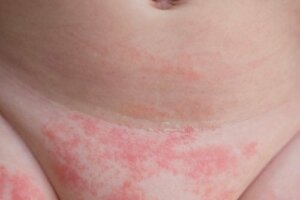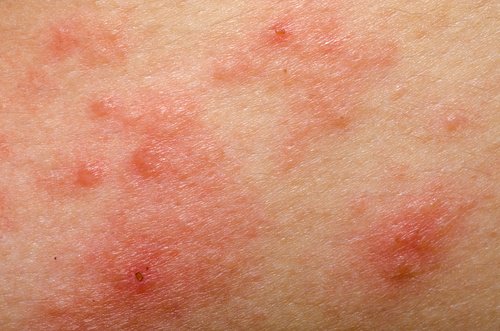Four Tips to Prevent Diaper Rash


Written and verified by the doctor Mario Benedetti Arzuza
Knowing how to prevent diaper rash in infants is an important thing each mother should know, especially first-time mothers. This is a skin condition or outbreaks on the area covered by the diaper.
In general, it appears at the bottom of the abdomen, genitals, buttocks and upper portion of the thighs, due to having direct exposure to irritants. This condition, which they also call dermatitis, often appears in babies during their first year of life.
Diagnosis and Causes of Dermatitis
The diagnosis of dermatitis should be done through physical examination. The symptoms of this disease consist of the appearance of skin lesions in areas that have direct contact with the diaper, as pointed out in this article published in Pediatría Integral. Some of its main causes are:
The main causes are:
- Sensitive skin before the diaper rubs against the baby’s skin
- Prolonged contact with urine and feces
- Altered pH in urine and feces
- Moisture
- Poor hygiene
Read this article, too: Should You Wake Your Baby to Change Their Diaper?
Tips to Prevent Diaper Rash

Here are some tips to prevent diaper rash:
1. Wash the baby’s private parts
Use plenty of warm water to wash the area covered by the diaper whenever you change your baby’s diapers. It’s best not to use soap when doing this activity. If necessary, you can use neutral pH washes.
Next, gently dry the area without rubbing on it. If possible, change your baby’s diaper in an open space. Avoid using wet cloths that contain alcohol or fragrances.
Check out this article, too: 7 Personal Hygiene Mistakes that Harm Your Health
2. Change your baby’s diaper regularly
On the other hand, it’s very important to change their diaper frequently, at least every three hours during the day, even if your baby has only urinated. At night, if possible, change their diaper every 5 hours. Also, it’s necessary to change your baby’s diaper every time they have a bowel movement.
Of course, every time you make the change, you should wash the baby with water and neutral soap, dry them well with a soft, clean towel and, as much as possible, leave them without a diaper for a moment so that the area can air out, as shown in this publication from Pediatría Integral.
Be careful when putting the diaper on, make sure that it isn’t too tight. This can lead to the diaper rubbing against your baby’s skin and give rise to irritation.
On the other hand, it’s important to pay attention to the characteristics of the diapers at the time of purchase. Those that have the “extra absorbent” feature aren’t recommended, since by retaining moisture for a longer period of time, they could produce the ideal environment for bacteria.
Remember that if dermatitis leads to lesions, there’s a greater risk that the wounds will become infected and cause more serious problems.
3. Use baby creams
Use baby creams in all areas that need it during every diaper change. These creams must be water-based and the components must have astringents, such as zinc oxide. Also, these creams form a waterproof layer on the skin, as pointed out in this article published in the journal Matronas Profesión.
It’s best to apply them after each cleaning of the area. You should do so because it can work as a protective barrier between the diaper and the skin. Therefore, it can prevent the appearance of irritations.
These can be purchased in pharmacies or supermarkets or you can try homemade recipes, but not before consulting your pediatrician.
4. Changes your baby’s diet

In addition to implementing all of the above, it’s important that you provide good nutrition for your baby. Consider keeping a record of the new foods your child eats, as some of these new foods may cause an alteration in the pH of the stool.
If you notice that the food is causing diaper rash, then immediately stop feeding it to your baby and consult with a pediatrician.
The same thing could even happen to babies that consume breast milk. In this case, the mother should control the food and medicines the baby consumes. Also, you should consult with a specialist when you plan on changing their daily diet.
Conclusion regarding how to prevent diaper rash
Finally, know that irritating diaper rash is common in children up to the age of 12 months. However, it’s important to try to apply all the recommendations we’ve mentioned to prevent their appearance, as much as possible.
If you maintain good care and, in general, proper hygiene, you’ll be able to save your child a lot of discomfort. As they say, prevention is the best medicine.
All cited sources were thoroughly reviewed by our team to ensure their quality, reliability, currency, and validity. The bibliography of this article was considered reliable and of academic or scientific accuracy.
- Román, T. P. (2016). Dermatitis del pañal y trastornos relacionados. PediatríaIntegral, 151. https://www.pediatriaintegral.es/wp-content/uploads/2016/05/Pediatria-Integral-XX-03_WEB.pdf#page=7
- Miñana, I. V. (2012). Trastornos cutáneos más frecuentes del recién nacido y del lactante. Dermatitis del pañal. PediatríaIntegral, 195. https://www.pediatriaintegral.es/wp-content/uploads/2012/06/Pediatria-Integral-XVI-3.pdf#page=7
- Enseñat, M. A. G. (2011). Dermatitis del pañal, prevención y tratamiento. Papel del Aloe vera. Matronas profesión, 12(3), 90-91. https://pdfs.semanticscholar.org/8a8a/b43180b984ab0abd28b62daef00900c20b21.pdf
This text is provided for informational purposes only and does not replace consultation with a professional. If in doubt, consult your specialist.








